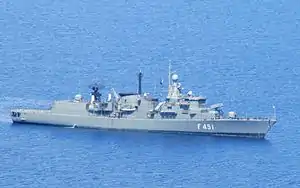Greek frigate Limnos
Limnos (F451) is an Elli-class frigate of the Hellenic Navy, and the third Greek warship to bear the name. The class is based on the Royal Netherlands Navy's Kortenaer class and was built in a Dutch shipyard; however, unlike later members of her class in the Hellenic Navy, she was not originally in Dutch service, but was sold directly to Greece. Limnos was constructed in Vlissingen, Netherlands, along with her sister ship Elli. The contract for her construction was signed in Athens in July 1981 and her commissioning took place on 18 September 1982. After commissioning, Limnos joined the Hellenic Fleet on 5 November 1982 and since then she has actively participated in its activities.
 | |
| History | |
|---|---|
| Name: | Limnos |
| Namesake: | Lemnos island and the Battle of Lemnos (1913) |
| Laid down: | 13 June 1978 |
| Launched: | 27 October 1979 |
| Commissioned: | 18 September 1982 |
| Status: | In active service |
| General characteristics | |
| Class and type: | Elli-class frigate |
| Displacement: | 3,500 tons (3,800 t max) |
| Length: | 130 m (426 ft 6 in) |
| Beam: | 14.6 m (47 ft 11 in) |
| Draft: | 6.2 m (20 ft 4 in) |
| Propulsion: |
|
| Speed: |
|
| Complement: | 196 |
| Armament: |
|
| Aircraft carried: | 2 AB 212 ASW helicopter or 1 Sikorsky S-70B-6 Aegean Hawk |
Service history
Limnos took part in several operations including Operation Desert Storm and Operation Desert Shield in 1990 and 1991. She was part of the security arrangements for the 2004 Summer Olympics in Athens as part of Operation Ifitos, and with Operation Ocean Shield, the NATO contribution to the anti-piracy initiative, in 2009. In 2011 she deployed with Operation Unified Protector, the NATO operation to enforce United Nations Security Council resolutions regarding the Libyan Civil War, and with Operation Active Endeavour, an anti-terrorism mission in the Mediterranean.
August 2020 collision with TCG Kemal Reis
On 13 August 2020, Turkish President Recep Tayyip Erdoğan announced that any attack on the Turkish research vessel Oruç Reis will incur a "high price" and suggested that Turkey had already acted on that warning. This came after unconfirmed reports that Limnos collided with the frigate Kemalreis, one of the ships of the Turkish Navy that were escorting Oruç Reis, which resumed drilling operations southeast of the Greek island of Kastellorizo on 10 August, after suspending its work in July.[2][3][4][5]
On the following day, the Hellenic Ministry of National Defence released a date stamped photograph of Limnos conducting joint drills with four other Greek frigates and two units of the French Navy in that same area.[6] According to unnamed "Greek defense sources", the Greek frigate manoeuvred to avoid a head-on collision, after Kemalreis attempted to "block" Limnos path and in the process its bow touched the rear of the Turkish frigate.[7] Initially, the Turkish frigate's fate remained unconfirmed, despite reports that mentioned it was deemed unoperational due to propeller damage, requiring return to port for repairs. Later on the same day and in response however, the Turkish Ministry of Defense released a video of the ship in social media, declaring that Kemalreis was also fully operational and its condition was unchanged, normally continuing its original mission. As a response to the Turkish President's statements, the Greek Ministry of Foreign Affairs issued a statement, announcing that the Greek Foreign Minister would brief in detail his European counterparts on the operational and technical details of that incident.
On 19 August, Greek newspaper Kathimerini published a photograph depicting the damage sustained to the right side of the stern of the Turkish frigate during the collision.[8]
On the same day several Turkish newspapers published a video depicting damage to the front-end of the Limnos frigate after a hit with the Turkish Kemal Reis frigate[9][10][11]
Coat of arms
The coat of arms of the ship is a copy of the battleship Lemnos's coat of arms. It depicts the lyra of the ancient poet and kitharode Arion and dolphins in waves.
References
- "Erdogan says Greece attacked Oruc Reis, 'got their first answer today'". Kathimerini. 13 August 2020. Retrieved 14 August 2020.
- "Turkey's Erdogan threatens Greece over energy dispute in Mediterranean". DW News. 13 August 2020. Retrieved 14 August 2020.
- "Erdogan says attack on Turkish ship in Mediterranean dispute will exact 'high price'". NBC News. 13 August 2020. Retrieved 14 August 2020.
- "Tensions in the Aegean: Greek frigate rams and damages Turkish war ship". Greek City Times. 13 August 2020. Retrieved 14 August 2020.
- "Joint Naval Exercise of Greece – France". Hellenic National Defence General Staff.
- "Greek and Turkish warships in 'mini collision,' says defense source". Kathimerini. 14 August 2020.
- "After collision, Athens plans next steps". Kathimerini. 19 August 2020. Retrieved 19 August 2020.
- https://www.yerelinsesi.com/iste-carpisma-ani-videosu/
- https://www.bihavadis.com/yunan-gemisine-kemal-reis-darbesi/8405/
- https://www.sondakika.com/haber/haber-son-dakika-cumhurbaskani-erdogan-dan-dogu-13507227
- Baker, A. D., ed. (1998). The Naval Institute Guide to Combat Fleets of the World 1998–1999. Annapolis, Maryland, USA: Naval Institute Press. ISBN 978-1-55750-111-0.
- Friedman, Norman (1997). The Naval Institute Guide to World Naval Weapon Systems 1997–1998. Annapolis, Maryland, USA: Naval Institute Press. ISBN 978-1-55750-268-1.
- Gardiner, Robert; Chumbley, Stephen, eds. (1995). Conway's All The World's Fighting Ships 1947–1995. Annapolis, Maryland, USA: Naval Institute Press. ISBN 978-1-55750-132-5.
- Moore, John, ed. (1979). Jane's Fighting Ships 1979–80. London: Jane's Yearbooks. ISBN 978-0-354-00587-6.
- Saunders, Stephen, ed. (2002). Jane's Fighting Ships 2002–2003. Coulsdon, UK: Jane's Information Group. ISBN 978-0-7106-2432-1.
